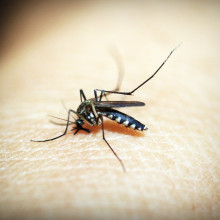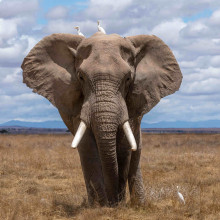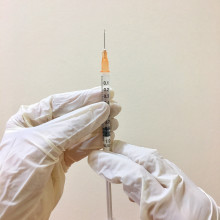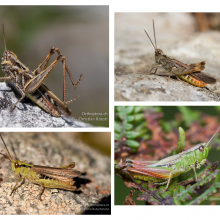Malaria vaccine, Fukushima wastewater & Nobel prizes
In the news pod: the WHO have recommended the Oxford Covid jab for use - we talk to someone who helped design it. We also speak with the scientist who questions whether the Fukushima wastewater disposal plans are as controversial as some would have us believe, and there's a round up of this year's Nobel prizes...
In this episode

00:59 - Malaria vaccine to save millions of lives
Malaria vaccine to save millions of lives
Lisa Stockdale, University of Oxford
The World Health Organization has approved a new malaria vaccine that can be produced on a massive scale. It’s hoped that the jab - which has been developed by researchers at the University of Oxford - can help turn the tide against a disease that has killed millions of babies and infants worldwide. So, how does the vaccine work? I’ve been speaking to immunologist Lisa Stockdale…
Lisa - This is a vaccine against malaria, a parasitic infection that kills hundreds of thousands of people a year. In terms of how it works, this vaccine shows the human body a part of the parasite, much like the Covid vaccine using spike to introduce the body to what the spike protein looks like, so that they're ready when they get infected. This is much the same but for malaria.
Chris - How do you actually do that? What's in the tin as it were that you put into the body with the vaccine?
Lisa - In the vaccine vial there is what we call a VLP, which is a virus-like particle. This isn't a virus, it's just that it's small and spherical and has a really high density of this malaria protein that we're trying to show the body on its surface. We inject this alongside what we call an adjuvant. This is a reagent that kicks the immune system into action. And so what happens is that this malaria specific protein on the surface of this vaccine is identified as a foreign object and then the body goes into its normal process of trying to get rid of it. And in that process it develops antibodies against that specific protein.
Chris - Is this an essential part of the parasite then? So if you make those antibodies and they're there waiting, when you encounter malaria for real it clogs it up. Is that how it works?
Lisa - Pretty much, yes. It is essential to the parasite's ability to infect human cells. And so when we inject somebody with this vaccine, we push the human body to make antibodies that are specific to that protein.
Chris - And how good is it in clinical trials?
Lisa - Incredibly good. We have been testing it in African countries that have malaria endemic in the population and the latest data that we have is that when it's administered to people living in areas where malaria is seasonal, this is 75% effective. So you would have 75% fewer people getting malaria if everybody got vaccinated.
Chris - Is this adults, children? Both?
Lisa - This is all children. 5 to 36 months olds.
Chris - There are multiple different types of malaria, aren't there? So will this work against all of them?
Lisa - It will not. So this vaccine that we've just had WHO recommendation for specifically targets plasmodium falciparum. Plasmodium is the malaria pathogen and then falciparum is the specific subtype. So there is also a malaria called vivax, which is particularly present in South America. And this vaccine unfortunately doesn't target that type of malaria.
Chris - Could it be adjusted, updated? Will the same strategy work or are we back to square one with these other forms of malaria?
Lisa - We think that it could be tweaked and actually that's something that our group is working on to try and see if we can make an alternative version of this vaccine specifically for vivax form.
Chris - And how long does the protection last for? Is this a one hit wonder? You have it once and then you are protected indefinitely? Or do you envisage We're going to have to do boosters.
Lisa - The way that the vaccine has been tested so far is that there are three doses given one month apart and then a booster dose given 12 months after the third dose. So that's what's been tested at the moment and that's what we've got data for. Earlier trials containing smaller numbers of participants have tested durability of the vaccine and we know that it maintains out to about three years, but we still need to do further work to understand exactly how long in greater numbers of people.
Chris - Yours is the second malaria vaccine that the WHO have recommended. What's the first one and how does yours compare to that one?
Lisa - The first one is called RTSS and it was developed by a company called GSK and that was recommended by WHO about this time two years ago. Our vaccine and RTSS target exactly the same protein on the surface of the malaria parasite so they are really similar, the main difference being that our vaccine is produced in a different organism and we get higher density proteins on the surface of our vaccine. So we think that that causes the immune response to be more specific to those proteins.
Chris - When are you hoping that this is going to be in the field and what sort of an impact do you think it's going to have?
Lisa - So the WHO have said that this is to be rolled out middle of next year, mid 2024. The manufacturer of the vaccine has vaccines stored and ready to go. And I think that the impact will be enormous. There's a huge issue with the current vaccine not having sufficient doses for the demand that's out there from African countries. So at the moment there's 18 million doses available between now and 2025 for RTSS, whereas the manufacturer that we are working with has said that their capacity is a hundred million doses a year, which could be doubled. So I think in terms of supply and demand, the impact of this WHO recommendation is absolutely enormous.

06:43 - Nobel Prize for Physics: blink and you'll miss it
Nobel Prize for Physics: blink and you'll miss it
Reporting on this year's Nobel Prize for Physics, Will Tingle:
Electrons are fundamental to electricity, magnetism, and processes in the cell, to name a few things. But they are very very small and very very fast. Anyone with a camera will tell you that taking a photo of a moving object with a long shutter speed means you get nothing but a blur. So, to have any hope of seeing electrons, you need a very short pulse of light. And that’s why this year’s Nobel Prize for Physics goes to three people: French-Swedish physicist Anne L'Huillier, French scientist Pierre Agostini and Hungarian-born Ferenc Krausz. With their powers combined, they have demonstrated how to create pulses of light so short that they can observe the way in which electrons move.
How short? Attosecond short. A billionth of a billionth of a second. There are more attoseconds in one second than there are seconds in the current age of the universe. How could you possibly hope to capture any sort of image in that short of a timeframe?
Well, you need to do some clever stuff with light.
Light is an electromagnetic wave. So the shortest pulse of light must consist of at least one full oscillation of the electromagnetic field.
Imagine a sine wave: that’s up, down, then up again. Traditional lasers can create a one wavelength pulse just fine.
But these lasers typically operate in the near-infrared region of the electromagnetic spectrum, where the wavelength is much longer than the scale of atoms. So seeing electrons is out of the question. A much shorter wavelength is needed.
The breakthrough came when it was discovered that an infrared laser, passed through gaseous atoms, interacts with these atoms and causes overtones.
Overtones are waves that complete a number of oscillations for each oscillation in the original wave, meaning they have a shorter wavelength.
Under the right conditions, the cycles of these overtones coincide, like when the indicator lamps in a queue of waiting cars suddenly all appear to be blinking in sync.
The scientists managed to synchronise the higher frequency overtones generated when their infrared pulses interacted with the gas atoms; the result is pulses of light with a much higher frequency.
And this is what allowed them to observe electrons at intervals that are small enough for them not to be blurred.
So why does this matter? Well, to understand something, you need to know where it is. And being able to pulse light for such a short period of time makes this possible for the world of electrons inside atoms and molecules.
It takes electrons 150 billion billionths of a second to go around the nucleus of a hydrogen atom. Before this breakthrough, we could only see the outline of an atom’s nucleus, but now we have the ability to see electron positions around atoms. And who knows, we could even start to manipulate where electrons go, which could have huge implications for stuff like solar energy.
Congratulations to Anne, Pierre, and Ferenc for their hard earned prize, and also thanks to Ioan Notingher of Nottingham University for helping me understand the science, which, I would argue, is an equally impressive task!

09:50 - Scientist rejects Fukushima wastewater outcry
Scientist rejects Fukushima wastewater outcry
Jim Smith, Portsmouth University
To Japan now, where the owners of the country’s badly damaged Fukushima nuclear power plant have begun releasing a second batch of treated radioactive wastewater into the sea. The wastewater will continue to be released for decades to come and it has prompted a furious response from fishing groups and neighbouring countries - including South Korea and China. The story goes back to 2011 when, in the aftermath of a massive offshore earthquake, an ensuing tsunami took out the plant’s power supply and caused three of the reactors to melt down, contaminating the site. Authorities there have cleaned up the site, but… from Portsmouth University, environmental scientist Jim Smith...
Jim - Since then, the Japanese have been storing what's called treated wastewater; water that's been produced from the cooling of the reactor on the site, rainwater that's filtered through the reactor buildings and is in groundwater, which has been pumped out. All that slightly radioactive water has been treated and stored in about a thousand giant tanks from the Fukushima site. In August of this year, 12 years after the accident, the Japanese decided to start discharging this treated wastewater into the Pacific Ocean. And this has caused a lot of controversy because some people have claimed that it's going to damage the ocean and marine ecosystem and it's going to damage people eating seafood from the Pacific. So I and a couple of colleagues in Australia wrote an article in the journal Science about why we think the scientific evidence shows that this release of treated wastewater isn't a risk to the Pacific.
Chris - What's actually in the water, Jim? If we analyse it, what sort of radioactive material are we talking about?
Jim - The water has been contaminated by things that are in the reactor core when it had its meltdown. So after both the Chernobyl and Fukushima accident, one of the main contaminants was a thing called radioactive cesium. Radioactive cesium can be damaging in the environment, but it's also relatively easy to treat in wastewater. So the Japanese have set up things called ion exchange columns, which take out the radioactive cesium and many of the other radioactive elements in the wastewater. What they can't strip out is a thing called tritium. So tritium is a radioactive form of hydrogen. And what happens in nuclear sites all over the world is that some of the water passing through the reactive becomes what we call tritiated. In other words, instead of having H2O, which is ordinary water, one of the hydrogens is replaced by its radioactive form tritium. So it becomes a thing called HTO, hydrogen tritium and oxygen. And the thing about tritiated water is, chemically, it's identical to ordinary water. It behaves exactly the same. And that means that it's incredibly difficult to take it out of the wastewater because chemically it can't be distinguished from all that massive ordinary water. In the thousand or so tanks at Fukushima, there's 1.3 million tons of water. Within that, there's about three grams of tritium. So separating that three grams is really, really difficult. And so what nuclear sites all over the world do with tritiated water is that they release it into the local river or lake or in into the ocean.
Chris - So what's the scale of the threat that that may pose?
Jim - Before it goes down the pipeline at Fukushima into the Pacific, it's diluted a hundred times. We measure radioactivity in becquerels. So there are 1,500 becquerels per litre of tritium in the wastewater when it's released. And just to get an idea of what that means, the World Health Organisation drinking water limit for tritium is 10,000 becquerels per litre, so about seven times higher. So it's really at a very low level. The other radioactive elements will be at less than 1% of the Japanese regulatory limit for discharge to the sea, which is already quite cautious. So in terms of what we expect to see from this release, we don't expect to see anything. Radiation doses have been calculated, not just from the tritium but from all the others. There are trace amounts of other radionuclides in the release. And even to people who are consuming seafood from that local area, the dose is about 2000 times less than the radiation dose that we all get from natural radioactivity in the ground, in the air, cosmic rays. So it's a really incredibly low dose. It equates to about a quarter of a dental x-ray.
Chris - I think one commentator put it that it's about a thousand times less than you'd get just flying from London to LA. So Prince Harry, every time he pops over to London to sue a newspaper, he gets a dose a thousand times bigger than you'd pick up from this.
Jim - Yeah, it's trivial compared to air radiation. So when we go above the atmosphere, we're exposed to more cosmic radiation, so frequent flyers can get significantly higher doses than other people just because they're above the atmosphere, and air crew as well.
Chris - So given that this actually appears in the grand scheme of things to be such a low risk, why has there been so much vocal opposition? Particularly, for instance, from China, because as one other person pointed out, the amount of operating coal fired power stations in China that are releasing radiation into the air, just by virtue of the fact you're burning something that contains trace amounts of radioactivity in the coal that you burn, China are releasing far more than this on a daily basis.
Jim - That's right. And China, of course, has lots of nuclear power stations which are also releasing more than this. So there's a nuclear power station in China that emits about nine times more tritium annually into the Pacific than this Fukushima release will do.
Chris - So why have the Chinese been so vocal against it? They've made quite a song and a dance about this.
Jim - I'm a scientist. I'm not a politician, but this has to be about politics. It's certainly not based on scientific evidence. In the Pacific, there are real environmental issues, which is climate change, plastic pollution, raw and treated sewage going into the Pacific, overfishing, there are real major environmental problems in the Pacific. And this Fukushima release is just not one of them.

15:30 - Nobel Prize for Chemistry: quantum dots discovery
Nobel Prize for Chemistry: quantum dots discovery
Guiding you through this year's Nobel Prize for Chemistry, James Tytko:
When it comes to chemistry, size certainly matters, and now one of the world's largest awards for the subject rewards some of the tiniest of entities we can make.
Known as quantum dots, these atomic-scale structures, a millionth of a millimetre across and composed of just a few thousand atoms, are tiny inorganic particles that glow a range of colours from red to blue when exposed to light. The colour they emit depends upon the size of the particle.
They are what make modern LED television screens and monitors possible; they also boost the efficiency of the photovoltaic cells we use to capture the Sun's energy, make highly-sensitive light detectors feasible, work as catalysts to speed up industrially important reactions such as hydrogen production, and work as diagnostic sensor molecules for medical imaging and disease.
All of this hinges on the fact that as particles become smaller, quantum effects kick in that alter their chemistry.
One of the winners, of this year's Nobel Prize, Russia's Alexey Ekimov, made the crucial observation in the early 1980s that stained glass changed colour according to how long and how hard it was heated. He correctly reasoned that tiny particles of copper in the glass were growing or shrinking with the temperature, and this was affecting the way they interacted with light.
Later, working in the US, Louis Brus made a similar observation that light-driven reactions involving solutions of the substance cadmium sulphide changed over time; he realised that the crystals were growing in the solution on his lab bench, and as their size changed, so did their quantum properties.
It was obvious that if the size and structure of the particles could be precisely controlled, there was huge potential to manipulate their chemical properties.
That breakthrough came in the early 1990s, when the third recipient, Moungi Bawendi, pioneered a way to make quantum dots with uniform sizes and prescribed sizes, opening to door to the technological, industrial and medical exploitation of the science that we see today.
So although the discovery hinges on the science of the very small, the implications and applications are huge and have been world-changing; moreover, it proves that size really does matter.

18:34 - The scariest sound in the savannah
The scariest sound in the savannah
Liana Zanette, University of Western Ontario
But first, to South Africa now, and a new study into the ecology of fear. The most terror-inducing sound in the whole of the African plains has been identified by researchers working in Kruger National Park. Will Tingle has the story...
Will - Take it from me: the soundscape of the South African Savannah contains many noises that might put the chills into you. From the strange roar of a lion to the unearthly hoot of an owl. And of course there are other noises to be wary of, but none of those inspired the most fear into animals. There is one more noise that causes mammal species to flee like no other. And if you haven't already guessed, it's this.
Speaker - My dad was a teacher, so I grew up in a home where everything I knew was sports. I played tennis, I played cricket, I played rugby. I loved my sports, especially cricket and rugby.
Will - Regular human conversation. Now I'm terrible at small talk, but not enough to flee for my life. But this is the case for nearly all of the mammals that use waterholes in the Greater Kruger area of South Africa. I spoke to lead author Liana Zanette from Western University Canada about what kind of fear normal human chatter can instil.
Liana - It was remarkable. Across the mammal community, 95% of the wildlife responded two times more fearfully to the humans, and they left the waterhole 40% faster than they did when they heard even lions.
Will - The implications of this are huge for several reasons. Not only has human speech been identified across a number of individual species, it has been singled out as one you can't afford to be anywhere near. And the question as to whether this fear is innate or learned is very difficult to answer. Naturally, awareness of predatory noise spreads quickly through a community, but there are also studies that say certain prey species fear the sound of predators that have been extinct in that area for sometimes many, many generations. All we can say is that fear of humans is a worldwide, deeply ingrained phenomenon. But the African bush is full of noises, birds, insects and what have you. So how do mammals in Kruger know what they're hearing is definitely human?
Liana - Because we talk a lot!The nice thing about using lions versus humans is that we're really quite similar in a lot of ways. Humans and lions have been competitors for prey for millennia, but also lions are large and they're group hunters. Humans are the second largest predator out there and we also are group hunters, but also lions talk a lot. And so it's not going to be anything unique. Prey are going to have experienced humans as predators forever. It's part of their evolutionary history. What's unique is our ecology as predators. We do lethally kill a lot of different species and what the wildlife out there is telling us is that they recognise this and they're not stupid. So if you have a dangerous predator that is 10 metres away from you, you do not hang out in the neighbourhood. You run and that's exactly what they do. They run or they leave the waterhole.
Will - They're still very well. So being fearful and therefore wary of a predator is surely a good thing, right?
Liana - Just the fear of predators can have effects on population numbers because scared prey eat less, so they're going to produce fewer offspring. We've shown in experiments that thinking that there are predators around does lead to 53% fewer kids that parents are able to produce. If fear of humans to this extent really does pervade the planet, then it really does at a new dimension to our worldwide impacts that we're having on the environment. Our mere presence on the landscape could be having enormous effects as well.
Will - The idea that just the presence of humans alone is driving down successful breeding rates in animals is definitely cause for concern and something to be considered for future conservation schemes. But there may actually be a way for conservationists to use this to their advantage.
Liana - The good news story, though, about all of this is that it's kind of the flip side. What we're interested in looking at then is whether or not we might be able to use fear of humans as a conservation tool to protect species. So for example, rhinos? In some of our work in South Africa, we show that those rhinos do not like it when they think that people are around. They flee and they leave the waterhole. And rhinos are really heavily poached in South Africa and it's possible that what we might be able to do is go to areas where there's heavy poaching, illegal hunting of rhinos and play something that rhinos do not like, which is humans talking, to keep rhinos out of those areas where they are heavily poached. There has been some research that shows that rhinos, on a long time scale, will stay away from areas where speakers have been set up and people are speaking. Thinking about the flip side is always a good thing.

23:33 - Nobel Prize for Medicine: mRNA Covid vaccines
Nobel Prize for Medicine: mRNA Covid vaccines
Chris Smith walks you through this year's Nobel Prize for medicine...
They've been administered to billions, and protected millions from severe Covid-19 infection. Now the mRNA vaccines that helped to conquer the SARS-CoV-2 pandemic have also secured a place in scientific history - with a Nobel Prize in Medicine - for the two scientists, Katalin Karako and Drew Weissman, who created them.
Ever since Edward Jenner carried out the first vaccination in 1796, vaccines have followed a fairly repetitive path: we inject weakened or related forms of infections or toxins; or we chemically brutalise infectious entities to render them harmless before administering the leftovers. Sometimes we modify harmless viruses to turn them into Trojan horses to carry inside the body key parts of infectious agents we want to protect against.
The net result is that the immune system makes antibody molecules - and to varying degrees white blood cells called T cells - that can neutralise and block the infectious threat should we meet it for real.
These methods work reliably and well, but they do have drawbacks. They can be slow and expensive to develop, live vaccines aren’t suitable for everyone, and when dealing with fast-evolving threats, it can be hard for the technology to keep pace with the infection.
But, from the moment that scientists cracked the genetic code and worked out how DNA stores our biochemical recipes, and transcribes the messages we needs into simpler, short lived copies called messenger RNA - or mRNA - strands, researchers realised that it might be possible to deliver our own messages into cells in a genetic form; including the instructions for substances normally used in vaccines, thus turning our cells into mini vaccine-manufacturing plants.
It sounded simple, but when scientists tried adding their own mRNA genetic codes to the body, the cells of the immune system somehow knew that the mRNA was foreign and destroyed it.
This was the challenge that confronted and frustrated Katalin Karako and Drew Weissman for many years. But their eureka moment came in 2005, when they showed that, compared with pristine mRNA made in a test tube or by microbes like bacteria, the mRNA strands found in our cells are chemically modified: extra molecules are added to some of the genetic letters in the sequence. It's a bit like the embellishments and decorations you see in old books around the opening letters of paragraphs. These enable the body to tell friend from foe.
So, they wondered, what would happen if they substituted more chemically colourful genetic letters into their mRNA genetic sequences? Would this avoid the immune trip wires that were being triggered?
Indeed it would. And the inflammatory response that had been thwarting their previous efforts was almost completely abolished, opening the door to the use of mRNA vaccines as a therapeutic vehicle.
There were still problems to overcome, of course, before the discovery could make its way into the clinic. Compared with it chemical relative DNA, mRNA - while easier to slip into our cells - is a much more fragile molecule, so scientists had to develop ways to package it in a stable form that would also ensure efficient delivery once it was injected.
The solution was to wrap up the mRNA molecules in tiny oily bubbles called lipid nanoparticles. Each shot of mRNA vaccine contains billions of them. Developing this technology was a breakthrough in its own right; and although Karako and Weissman developed the engine that powers the mRNA vaccine vehicle, some scientists have argued that the body of the car - in the form of the lipid nanoparticles - also deserved Nobel recognition. But, with so many researchers involved in this aspect of the work, it would have been arguably more unfair to single out just one for the award.
Before the pandemic struck, the technology had been quietly evolving in the background. mRNA-based vaccines for Zika, and a virus that is a close relative of the Covid virus, had both been developed and tested in animals.
But the Covid pandemic offered the opportunity to capitalise on the power and agility of this new approach in clinical medicine. The vaccines are easy to make, and update, at scale and very safe. And off the back of the impetus from Covid-19, the approach is unlocking new treatments for cancer, as well as other infectious and degenerative diseases.
COVID-19 gave mRNA vaccines the shot in the arm that the industry needed, but the technology’s impact is likely to reach far and wide, hence its recognition by the Nobel committee. As Kariko herself says, "It is just limitless."

27:53 - Where do new species come from?
Where do new species come from?
Evolution is considered a long and slow process, especially when it comes to the formation of new species...
Since Charles Darwin and other scientists of the 19th Century drafted the first theories of evolution, biologists have studied and partly unveiled this mysterious process that has endowed Earth with the amazing diversity of creatures we witness today. Yet, we still don’t understand entirely the intricate mechanisms that drive the formation of new species, and it has only recently become clear that, given the right conditions, new species can appear quite rapidly.
For the first evolutionary biologists such as Darwin and Alfred Russell Wallace, the emergence of new species - speciation - was principally visible on a continental scale. They observed that populations separated over large distances and long periods of time had adapted differently to their environments and taken separate evolutionary paths. With the lack of tools or even knowledge of genetics, evolution was a process that could only be witnessed with the eyes. Darwin understood that the birds on several islands of the Galapagos looked similar to each other and to those of the American continent, yet showed several key differences, like the sizes of their beaks. This helped him develop the idea of species changing and adapting to new environments through natural selection. It was, however, much harder to explain how new species arose in the absence of geographical barriers and through forces different from natural selection.
The study of evolution took a gigantic step forward with the arrival of genetics and the advances that have been made since Gregor Mendel devised the first principles in the garden of the monastery where he grew his famous peas. Nowadays, thanks to the enormous progress in scientific technology, we can affordably sequence entire genomes in a matter of days, grow thousands of parallel cell-cultures in the laboratory and do even more insane things that were completely unimaginable fifteen years ago. We can now witness evolution on smaller and larger scales than Darwin and Wallace could with their naked eyes. It is now, more than ever, that we realise how ubiquitous and diverse evolution truly is.
As a graduate student at the Ludwig-Maximilians-Universität in Munich, I got the chance to study the process of speciation through a very interesting set of grasshopper species grouped under the genus name Chorthippus. These different species all look incredibly similar, making it practically impossible for biologists to distinguish them based on their appearances. To make the distinction even more challenging, the species co-exist in large areas of Europe, occurring side-by-side even in the very same meadows. Yet, taxonomists have classified them into separate species according to the distinctive mating songs of the males. More recent studies however, have questioned whether one could rightfully categorise Chorthippus grasshoppers into different species. First, researchers discovered that the species can mate and produce healthy hybrid offspring when forced to do so in the lab. If the animals were doing this in the wild, one could argue they were just a single species with many song variations. Secondly, phylogenetic research on the Chorthippus group showed that grasshoppers supposedly belonging to different species were genetically so closely related that it wasn’t possible to place them in different groups. Yet, this study was only based on a minute part of the gigantic grasshopper genome, turning it into the equivalent of looking at a single brush-stroke of an inmense, intricate and detailed painting.
With these different findings in mind, there were two possible scenarios for the evolutionary history of Chorthippus grasshoppers. In one, they interbred in the wild and couldn’t be considered as different species. The other possibility was that the different species formed so recently that they had not yet reached the stage of being physically unable to reproduce and hadn’t diverged enough genetically to detect it with small-scale genetic studies. If the latter case were true, a barrier must exist that prevents the different species from mating in nature. We knew the species could be found together in the same grass fields of Central and Western Europe, so unlike Darwin’s finches, it was not geography or ecology that separated them. The best separating candidates we had were the different mating songs of the grasshopper males: if the females had evolved to choose only mates who sing the song of their own, they might never or very rarely outbreed, leading to a segregation of different singing groups in the same physical space. It was now my - and my supervisor’s - task to find out which of these two possibilities is true.
Although the research on this specific question was going to be entirely computer-based, I got introduced to living, wild Chorthippus grasshoppers when my supervisor invited me on a field trip to the Pyrenees for a side-project of his, shortly before starting my thesis. The plan was to drive all the way from Munich to the French-Spanish border (and back) to catch two types of grasshoppers which coexist exclusively there for breeding experiments in the lab. After two full days of driving through the Swiss lowlands, the French pre-Alps and Côte d’Azur, we finally arrived in a small Spanish mountain town where our collaborators from Madrid were waiting with a beer in the excruciating summer heat. On that same day, I got acquainted with the tiny grasshoppers and the surprisingly difficult task of telling them apart. The senior scientists in our team tried to teach me how to detect the one species we were looking for and how to tell adults and nymphs, males and females apart. But, in all honesty, until the last day I was still finding myself running over the grass following what I thought was the desired species, hunting the insect down only to discard it with a disappointed face when I realised it was in fact a very similar-looking Chorthippus cousin. Yet, no matter how inexperienced I was, and how difficult the grasshopper hunt could be, it was a real pleasure to work surrounded by such fantastic landscapes out in the open, fresh mountain air. After a day of catching insects, we would come back down the mountain, take care of our living catch and enjoy the cooler hours of the evening with the team. A couple of days later, my supervisor and I left the Pyrenees with more than 250 vividly jumping and singing grasshoppers in cooled plastic bottles filled with grass on the back seat.
After that small fieldwork adventure, it was time to get to the real business. I had become acquainted with my study species, but had now a question to answer which could not be resolved by mere fieldwork. The answer on whether the grasshoppers bred out or not hid in their DNA. However, doing genetic research nowadays requires much more preparatory work on the computer than one would imagine. Although the lab-work of extracting and sequencing DNA from animal tissue had already been done for us by different labs, we now had to sort, clean and standardise the genetic information that had been loaded onto the Internet by several different scientists around the world. Since I was learning while working, it took me around two months to have the primary DNA sequences ready for the first analyses. While it was getting increasingly dark and cold in Munich, I started to master the skills of computer coding and the first results started to roll in. My work was a long way removed from what is generally considered a biologist’s job: no damp jungles or vast savannas for me to explore. Instead, millions and millions of letters of genetic code on post-apocalyptic black screens with green digital text reminiscent of the Matrix. Yet, I was deeply enjoying the computer work: even if I wasn’t venturing deep into the natural world, I was still on a treasure hunt for answers on evolutionary questions. And, eventually, when Munich was at its coldest and not a single grasshopper could be alive in the surrounding fields of the university buildings, it seemed as though my supervisor and I had figured out whether a millennia-long love story had ever existed between the Chorthippus grasshoppers, or not.
Fantastically enough, even though they live centimetres away from each other and could perfectly mate, our set of grasshopper species seemed not to do so. Their genetic codes told us that the different species were cleanly separated, with no signs of interbreeding at all. Stranger still, we discovered that these grasshopper species were extremely "young", arising most probably within the last 12 000 years ago, during or after the last Ice Age. At this time in history, human beings were already developing agriculture and building the first settlements. On an evolutionary timescale, these species had formed in seconds. As for why the grasshoppers developed different songs and evolved into different species, the answer remains unclear. One possibility could be that they were physically segregated in the past, for example in separate refugia during the Ice Age, and were reunited once the ice pulled back. But it is equally possible that the species only started to diversify afterwards, during their expansion towards the newly-freed territories of Europe. What is fascinating about these tiny grasshopper species is that, despite their young age and great similarity, they still maintain a very clear barrier – in this case generated by the search for a mate - and not directly by the survival in a new environment.
Our grasshoppers showed us, once again, that new species can arise and be maintained in many different ways other than complete geographical isolation and natural selection. This kind of evidence for evolution was hard to perceive for Darwin and Wallace, yet, with the help of modern tools and computers, we can now understand the diversity of evolutionary paths that nature embarks upon everywhere and all the time around us. We are still far from having grasped the entire book of evolution, but it is by unravelling the origin of the tiniest - and seemingly most insignificant - creatures around us that we learn more about this astonishing process. Next time you hear a grasshopper sing in your yard, think about the blind but marvelously intricate tinkering and engineering behind it, which has composed that melody precisely so that it can be distinguished from all other sounds and songs around it. Nature is full of secrets and surprises, waiting for us to discover, and in every creature, may it be a plant, animal, or something else, we can find traces of this endlessly fascinating process.










Comments
Add a comment